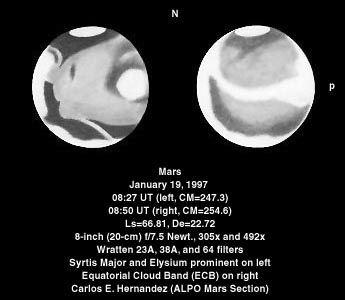

This set of Mars observations was made on January 19, 1997 (Ls=66.81, De=22.72) at 08:20 UT (figure on the left, Wratten 23A (light red) filter, CM=247.3) and 08:50 UT (on the right, Wratten 38A (blue) filter, CM=254.6) by Carlos E. Hernandez (ALPO Mars Recorder) using an 8-inch (20-cm) f/7.5 Newtonian reflector at 305x and 492x.
The figure on the left, made while employing a Wratten 23A (light red) filter, shows a brilliant (10/10) North Polar Cap (NPC) surrounded by a dark (3/10) collar consisting of Panchaia, Lemuria, Uchronia, and Utopia (preceding (p.) to following (f.)). Casius appears as a dark (3/10), wedge-shaped albedo feature which extends north from Utopia. Nodus Alcyonius appears as a dark (3/10), elongated (north-south) albedo feature south-preceding (Sp.) Casius. Boreosyrtis appears as a dark to dusky (3-4/10), curvilinear albedo feature f. Casius towards the f., or morning, limb. Elysium appears very bright (8/10) adjacent to the terminator, or p. limb. South-following (Sf.) Elysium the Trivium Charontis complex appears dark (3/10) Sp., to the north (N.) a dark to dusky (3-4/10) Chaos , North-following (NF.) a dark (3/10) Hyblaeus extension (3/10) Nf., and a dusky (4/10) Eunostos I Sf. Elysium. Cebrenia appears dark to dusky (3-4/10) to the north of Elysium. Mare Cimmerium appears dark (3/10) towards the southern limb p. the CM with a dark (3/10) wedge-shaped Tritonis Sinus at its f. end. A dark (3/10) Mare Tyrrhenum appears to be separated from Mare Cimmerium by a bright (7/10), "strip-like" Hesperia. Syrtis Major appears as a dark (3/10) "bar-like" albedo feature adjacent to an extremely bright (9/10) morning limb haze (MLH). The southern limb appears to be covered by an extremely bright (9/10) haze that appears to connect to an equally bright MLH.
The figure on the right, made while employing a Wratten 38A (blue) filter, shows a brilliant North Polar Cap (NPC) with a dusky (4/10) NPC collar, described above, to the south. An extremely bright (9/10) oval-shaped cloud appears over Elysium apparently connected to an equally bright terminator, or evening limb haze (ELH). An extremely bright (9/10) morning limb haze (MLH), or f. limb is noted apparently connected to an equally bright southern limb haze (SLH). A rare equatorial cloud band (ECB) is noted to extend from Elysium to the Neith Regio-Meroe Insula region over Amenthes and Isidis Regio. The ECB is best detected at ultraviolet (UV) and violet light, and therefore, resides at chilly high altitudes and probably is composed of carbon dioxide (CO2) crystals. The appearance of an ECB is associated with the sublimation of the polar caps. The southern maria (Mare Cimmerium, Mare Tyrrhenum, and Syrtis Major from p. to f.) appear as a dusky (4/10) curvilinear border north of an extremely bright (9/10) SLH.
The above observations show the value of observing Mars, or any other planet, with filters in order to better delineate the relative height (altitude) of features observed over the disk of Mars (i.e. a red (W 23A or 25) filter for surface features and a blue (W38A or 80A) filter for meteorological (cloud) features).